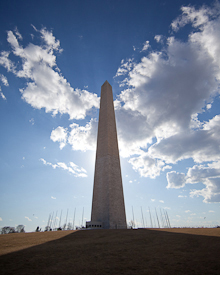By Jennifer Eder
If you had no restrictions, what would you do to enhance the grounds around the Washington Monument?
That's the question more than 500 people answered during the first round of a national design competition for how to improve the 60-acre public space – equivalent to more than 28 football fields – surrounding the Washington Monument.
The purpose of the National Ideas Competition, which is sponsored in part by GW, is to encourage Americans to develop innovative ideas for making the Washington Monument grounds more welcoming, educational and effectively used by the public.
“The goal is to start a dialogue for how to better enhance this space in the 21st century,” says Lisa Benton-Short, assistant professor of geography in the Columbian College of Arts and Sciences. “Imagine what could be possible even if it’s not feasible because it might be possible sometime in the future. If you’re not bound by regulations, much more creative ideas are born”
Dr. Benton-Short, who specializes in urban geography and public spaces, is one of four GW professors serving on the competition’s nine-member steering committee. Adele Ashkar, director of GW’s Landscape Design Program in the College of Professional Studies; Kenneth Bowling, adjunct associate professor of history in Columbian College and documentary co-editor of GW’s First Federal Congress Project; and Richard Longstreth, director of GW’s graduate program in historic preservation and a professor of American studies in Columbian College, also serve on the steering committee.
The competition launched last summer when the committee invited anyone age 12 and over, including artists, historians, educators, architects and landscape designers, to submit their ideas for the future of this civic space. Design submissions of no more than two pages were due by December.
More than 500 people from across the U.S. and around the world submitted their ideas, and the seven-member jury, which consists of designers, historians, cultural leaders and city planners, chose 24 semifinalists.
“We were looking for intriguing ideas that also captured the special quality of this public open space in the center of the National Mall, and in some cases the best ideas were presented very simply, capturing a thoughtful approach to history and meaning with a compelling design statement or conceptual sketch,” says Raymond Gastil, chair of the competition’s jury and a well-known city planner.
Many of the winning entries offered subtle, minimal projects that used shadows, low plantings and specific messaging, while others proposed projects like building an amphitheater and an underground museum space.
All competition participants will receive a certificate and will be eligible for being included in the catalogue that will be published and posted online at the end of the competition to showcase the various submissions.
Sarah Allison, a GW graduate student pursing a master’s in fine arts, decided to enter the competition after completing a mock-up in Dr. Benton-Short’s graduate seminar in urban sustainability. Her idea is to build a memorial garden within the Washington Monument grounds in honor of George Washington being an avid farmer.
“Washington was a strong developer in American agriculture. Washington harvested fruits and vegetables by perfecting methods and tools used for cultivation,” says Ms. Allison, who hopes the garden could be an urban model of responsible horticulture. “I think it is important for D.C. residents to think about their role in developing what visitors will take away from our capital city and what a memorial for George Washington should be like.”
The 24 semifinalists will each receive a $100 prize as well as a stipend to help them enter the second stage of the competition where they will expand their idea into a proposal suitable for public exhibition. The jury will then select five finalists in the spring. Those five finalists will receive design and technical assistance before posting their ideas on the competition’s website this summer for public vote. The public will choose three winners and two honorable mentions.
Ms. Ashkar says it’s fitting for GW to be involved in this competition because the university and the monument share the same namesake.
“As a university, we can facilitate ideas in a collegial way and not get into political conversations surrounding the Mall,” she said. “We hope that we can continue to stimulate a conversation about what this space will mean for future generations.”
Dr. Benton-Short says she hopes Congress gets the message that Americans care about the Washington Monument grounds.
“For years, the facilities have been neglected, and the grounds have not been appropriated the necessary funds,” she says. “Congress just doesn’t seem committed to making sure the National Mall is a premiere civic space.”
After all, the National Mall is by definition a national public space and therefore belongs to all Americans, says Dr. Benton-Short.
“But in reality, they rarely get a chance to voice their opinion about what happens in this space,” she says. “The Mall is America’s front yard.”


